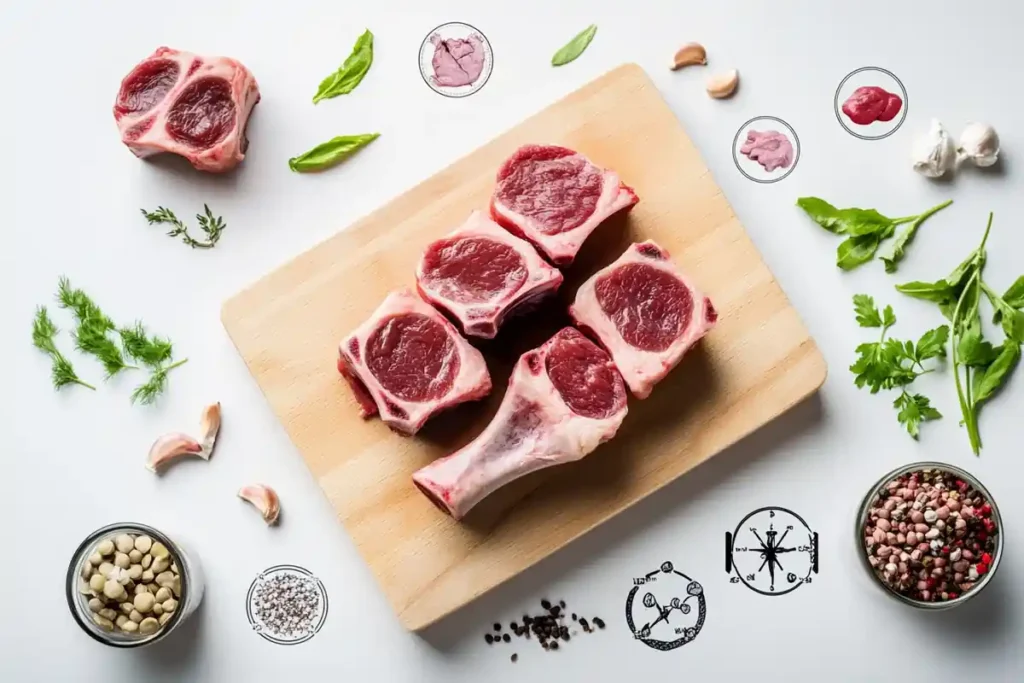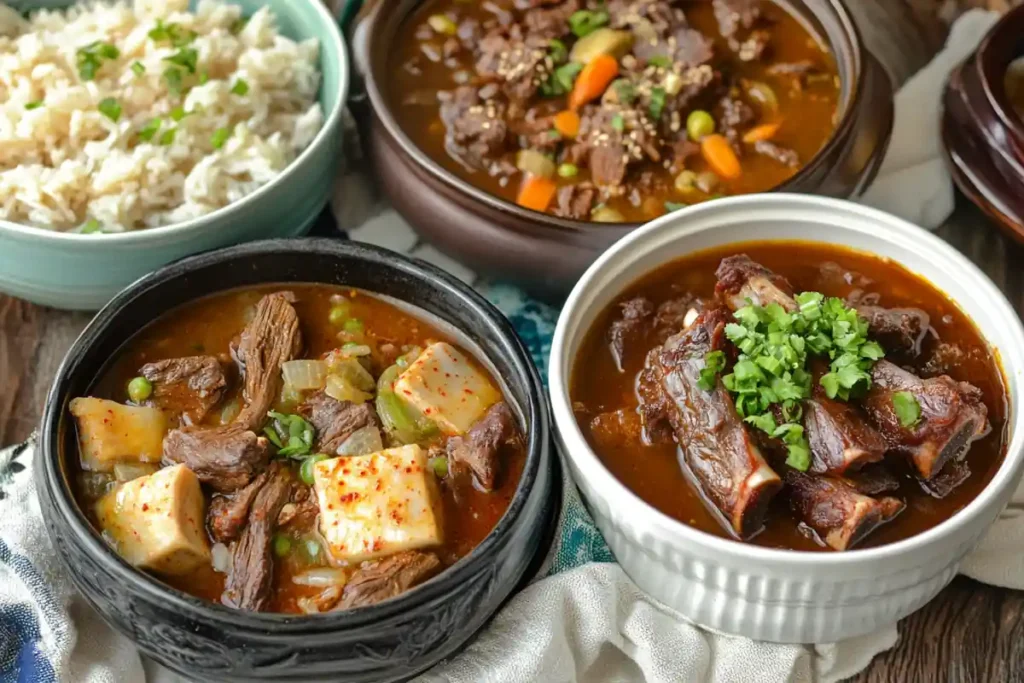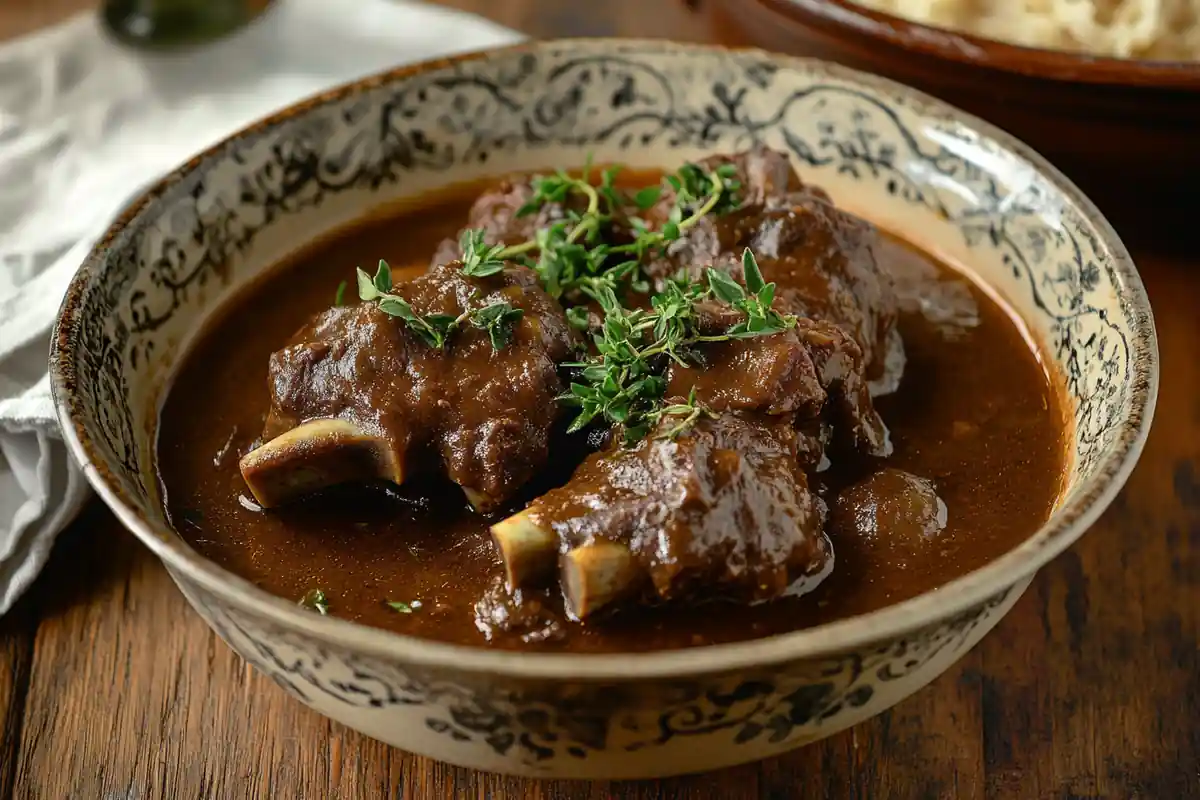When most people think of mouthwatering beef dishes, they often picture ribeyes, briskets, or oxtail. But there’s a hidden gem that’s budget-friendly, rich in flavor, and packed with nutrients beef neck bones. Often overlooked, this cut delivers deep, meaty richness that transforms simple meals into soul-soothing comfort food.
In this article, we’ll uncover everything you need to know about beef neck bones from their nutritional value and traditional uses to expert cooking tips and cultural significance. Whether you’re a curious home cook or a seasoned foodie, this guide will help you make the most of this underrated cut.
Table of Contents
Introduction
What Are Beef Neck Bones, and Why Should You Care?
Beef neck bones come from the section behind the cow’s head, and while they may not look fancy, they’re a powerhouse of flavor. These bones contain a generous amount of meat, connective tissue, and collagen that becomes irresistibly tender when slow-cooked.
Despite being one of the most affordable cuts at the butcher shop, they’re loaded with culinary potential. When properly cooked, they fall right off the bone, giving you juicy, melt-in-your-mouth meat that’s perfect for stews, soups, and broths.
Plus, they’re budget-friendly, making them an excellent choice for families or meal-preppers looking to stretch their grocery dollars without compromising on taste.
Why Are Beef Neck Bones So Underrated?
Honestly? It’s because they’re misunderstood.
Here’s why they’ve flown under the radar:
- They require longer cooking times, which may seem like a hassle in a fast-paced kitchen.
- Their appearance isn’t fancy, which turns off some folks who buy with their eyes.
- They’re less common in modern Western recipes, making them a bit unfamiliar.
But here’s the thing the time you invest in cooking beef neck bones pays off tenfold in flavor. Once you try them, it’s hard to go back!
The Flavor Profile: Bold, Beefy, and Beautiful
If you’re someone who loves bold, slow-cooked dishes, this cut is your dream. The flavor is deep and complex, especially when braised, roasted, or simmered in a hearty broth. The bones release collagen, which gives dishes a luscious texture that’s perfect for soul food classics and ethnic favorites.
And the best part? They’re versatile.
You can:
- Braise them with root vegetables
- Slow-cook them in tomato sauce
- Roast them with herbs and garlic
- Use them to make rich beef neck bone broth or stock
So, if you’re ready to give your taste buds a serious upgrade, stick around. You’re about to fall in love with the flavorful world of beef neck bones.
Nutritional Value of Beef Neck Bones
Why Beef Neck Bones Are a Nutrient Powerhouse
When it comes to beef neck bones, you’re not just getting flavor you’re getting a nutritional bang for your buck. These bones are loaded with vital nutrients that support overall health and wellness. So, while you’re savoring every bite, your body’s also saying thank you.
Unlike leaner cuts, beef neck bones contain a healthy mix of protein, fat, collagen, and trace minerals that your body craves. And the best part? When slow-cooked, these nutrients become more bioavailable, meaning they’re easier for your body to absorb.

What’s Inside: A Closer Look at the Nutrition
Here’s a breakdown of the key nutrients packed into a serving of beef neck bones:
- High-Quality Protein – Supports muscle repair and boosts satiety.
- Collagen & Gelatin – Promotes joint health, skin elasticity, and gut health.
- Iron – Helps transport oxygen through your blood, boosting energy.
- Phosphorus & Magnesium – Crucial for bone health and metabolic function.
- Zinc – Supports immune system function and wound healing.
- B Vitamins – Especially B12, for energy production and brain function.
Each serving delivers a nourishing blend that makes these bones ideal for everything from recovery meals to comforting cold-weather dishes.
Low Waste, High Benefit: Whole-Food Nutrition
One of the best things about beef neck bones? They allow you to cook nose-to-tail, reducing waste and making use of cuts that are often discarded. This not only supports a more sustainable food system, but also maximizes nutrition.
By simmering the bones long enough, you draw out minerals directly from the bone marrow and cartilage something you don’t get with leaner, boneless cuts.
How Do They Compare to Other Cuts?
Let’s do a quick comparison:
| Cut | Protein | Fat | Collagen | Price |
|---|---|---|---|---|
| Beef Neck Bones | High | Medium | Very High | Low |
| Ribeye | High | High | Low | High |
| Brisket | Medium | High | Medium | Medium |
| Oxtail | High | High | Very High | Very High |
As you can see, beef neck bones offer similar benefits to oxtail but at half the price making them a total steal for anyone looking to eat well without blowing the budget.
For more on the nutrient-rich power of bones, check out Food & Wine’s guide to making bone broth. It’s a great companion to cooking with beef neck bones!
Traditional and Modern Recipes Using Beef Neck Bones
Classic Comfort: Traditional Dishes Made with Beef Neck Bones
For generations, beef neck bones have been a staple in Southern cooking, soul food, and family recipes passed down through the years. These traditional dishes aren’t just hearty they’re filled with rich, nostalgic flavors.
Here are a few timeless ways people have been enjoying beef neck bones:
- Southern Braised Beef Neck Bones
Slow-simmered in a savory gravy with onions, garlic, and spices until the meat falls off the bone. Served with rice or mashed potatoes. - Beef Neck Bones Soup
A warming broth loaded with vegetables and tender meat, perfect for chilly nights. - Neck Bone Stew
A thick, hearty stew using root vegetables, herbs, and sometimes beans. The bones add an unmistakable richness to the broth. - Beef Neck Bone Gravy
Simmered until tender, then reduced into a deep, brown gravy poured over rice or cornbread.
These recipes prove that beef neck bones aren’t just for broths they’re the star of the plate.
Beef Neck Bones in Modern Cuisine
Nowadays, adventurous home cooks and chefs are rediscovering the versatility of beef neck bones. From international twists to bold new flavor profiles, this cut is gaining a modern spotlight.
Try out these trendy takes:
- Jamaican-Style Curry Neck Bones
Marinated in curry powder, thyme, and scotch bonnet (optional), then simmered until juicy and spiced just right. - Korean Gomguk (Neck Bone Soup)
A traditional Korean broth where beef neck bones are boiled for hours to create a milky, collagen-rich soup. Add radish and green onion for a full meal. - Smoky BBQ Neck Bones
Roasted in the oven and glazed with smoky barbecue sauce. Think of it like ribs but with even more flavor. - Instant Pot Neck Bones with Tomatoes & Herbs
Perfect for busy weeknights. This quick-cooked version brings tenderness and flavor in under an hour.
With just a few tweaks, beef neck bones can fit into almost any cuisine from fusion to keto, paleo, or high-protein meal plans.
Essential Cooking Techniques for Beef Neck Bones
To get the most out of beef neck bones, you’ve gotta cook them low and slow or smart and fast. Here’s how:

Slow-Cooking (Stovetop or Crockpot)
- Best for soups, stews, and braised dishes
- Cook on low for 6–8 hours
- Add aromatics like garlic, thyme, bay leaves, and onions
Pressure Cooking
- Great for quick meals
- Tenderizes in 45–60 minutes
- Lock in nutrients and flavor fast
Oven Braising
- Brown first in a Dutch oven, then add liquid
- Roast at 300°F for 3–4 hours
- Perfect for making beef neck bone gravy or roasts
Roasting
- Coat with oil and seasoning
- Roast at 375°F for crispy edges and a smoky finish
How to Buy and Prepare Beef Neck Bones
How to Select Quality Beef Neck Bones at the Store or Butcher
Picking the right beef neck bones can make a big difference in your final dish. While they’re not always front-and-center in grocery store meat aisles, a little know-how can go a long way.
Here’s what to look for:
- Color: Choose bones with deep red meat and creamy white fat. Avoid bones that look gray or dried out.
- Meat-to-Bone Ratio: Look for pieces with a good amount of meat still attached. You want to see thick chunks of beef surrounding the bone.
- Size Consistency: Uniform-sized neck bones cook more evenly, especially when making stews or roasts.
- Freshness: Always check the packaging date, or ask your butcher when the bones were cut.
Pro tip: If your local store doesn’t stock beef neck bones, ask the butcher directly. They often have them available behind the counter or can order them fresh.

Beef Neck Bones: Where to Buy for the Best Quality and Price
Wondering where to score this underrated gem?
Try these spots:
- Local butcher shops (often the freshest)
- Ethnic grocery stores (especially Korean, Jamaican, and Latin markets)
- Online meat suppliers (yes, they’ll ship frozen!)
- Farmers’ markets or farm co-ops
Because they’re still considered a budget cut, beef neck bones usually cost much less than short ribs or oxtail while delivering just as much flavor.
How to Prepare Beef Neck Bones Before Cooking
Once you’ve brought them home, a few simple steps can take your neck bone dishes to the next level.
Step-by-Step Prep Guide:
- Rinse
Rinse the bones under cold water to remove bone fragments and excess blood. - Soak (Optional)
Some cooks soak beef neck bones in cold water with a splash of vinegar for 30 minutes to draw out impurities. This helps clarify your broth. - Trim Excess Fat
If your bones are overly fatty, trim a little to prevent greasy dishes. But don’t remove all the fat — it brings flavor! - Season or Marinate
Before searing or braising, season with salt, pepper, garlic powder, paprika, or a spice mix. Let them sit for 15–30 minutes to absorb flavors. - Sear Before Cooking
Always brown the bones in oil to build flavor and seal in the juices. This simple step adds richness to everything from soups to gravies.
Cultural Significance of Beef Neck Bones in Global Cuisines
Beef Neck Bones Around the World: A Global Culinary Treasure
From the American South to Asia and the Caribbean, beef neck bones hold a special place in the hearts (and kitchens) of people around the globe. They’re often the centerpiece of family-style comfort food, steeped in tradition, and passed down through generations.

Southern Soul Food (USA)
In many Southern kitchens, beef neck bones are simmered for hours in onion gravy, seasoned with spices, and served over rice, greens, or cornbread. It’s a meal packed with soul hearty, affordable, and cooked with love.
Jamaican Cuisine
In Jamaica, beef neck bones are often seasoned with curry powder, thyme, garlic, and pimento, then slow-cooked to perfection. This dish brings layers of heat and warmth that pair beautifully with rice and peas.
Korean Cuisine (Gomguk or Kkori Gomtang)
In Korean cooking, gomguk (곰국) or neck bone soup is a nourishing dish where bones are simmered until the broth becomes milky white and rich in collagen. Served with green onions and radish, it’s a beloved comfort food, especially in winter.
Mexican and Latin American Dishes
In Latin American households, beef neck bones often make their way into caldo (soup) or guisados (stews). Combined with chiles, tomatoes, cumin, and cilantro, these dishes offer bold flavors with tender, juicy meat.
Why So Many Cultures Use Beef Neck Bones
Here’s why this cut is so beloved:
- Affordability: Economical yet flavorful perfect for large families and gatherings.
- Flavor: Bones release deep, beefy notes and natural richness that elevate any dish.
- Tradition: Neck bone recipes are passed down through generations, often tied to celebrations and everyday meals.
- Nutrition: Bone-in cuts like this are seen as nutrient-dense and ideal for soups meant to heal and nourish.
It’s clear: no matter where you are in the world, beef neck bones are more than just a cut of meat they’re a cultural cornerstone.
Frequently Asked Questions
Are Beef Neck Bones Good to Eat?
Absolutely! Beef neck bones are not only good to eat they’re incredibly flavorful and nutrient-rich. When cooked slowly, the meat becomes fork-tender and absorbs the spices and broth like a sponge. If you enjoy bold, comforting meals with deep flavor, this cut is a hidden gem.
How Long Should You Cook Beef Neck Bones?
The ideal cooking time depends on the method you choose:
- Slow Cooker: 6–8 hours on low
- Stovetop Simmer: 3–4 hours
- Pressure Cooker: 45–60 minutes
- Oven Braised: 3–4 hours at 300°F
Beef neck bones are all about that low-and-slow magic, allowing the collagen to break down and meat to fall right off the bone.
Can You Use Beef Neck Bones for Bone Broth?
Yes and they’re perfect for it. Thanks to the collagen and marrow inside the bones, they create a gelatin-rich, healing broth that supports joint, gut, and skin health.
To make broth:
- Roast the bones first for added depth of flavor.
- Simmer for 12–24 hours with aromatics (onion, garlic, celery, bay leaf).
- Strain and store in jars — use in soups, stews, or sip it like tea!
What’s the Difference Between Beef Neck Bones and Oxtail?
Great question! Both are bone-in beef cuts known for their rich flavor and collagen content. Here’s how they differ:
| Feature | Beef Neck Bones | Oxtail |
|---|---|---|
| Price | Lower | Higher |
| Meat Content | Moderate to high | High |
| Bone Size | Thinner, longer bones | Round, thick bones |
| Flavor Profile | Deep, meaty, slightly earthy | Rich, slightly sweet |
While oxtail may be more well-known, beef neck bones are a more affordable alternative that delivers just as much flavor.
Expert Tips for Cooking Beef Neck Bones Like a Pro
Let’s wrap up this section with a few quick-fire tips to make your next neck bone meal unforgettable:
- Always brown first: Searing adds a savory crust that deepens the dish.
- Don’t rush it: The longer the cook time, the more tender the meat.
- Use bones with meat attached: More meat = more satisfaction.
- Add acid: A splash of vinegar or tomato helps break down the collagen and balance richness.
- Chill your broth: Once cooled, you can skim off any excess fat easily.
Whether you’re tossing them in a stew or creating a bold broth, mastering beef neck bones just takes a little time and a lot of love.
Conclusion
Beef neck bones might not be the prettiest cut in the butcher’s case, but don’t let appearances fool you they’re pure gold in the kitchen.
From soul-warming Southern stews to spicy Jamaican curries and healing Korean broths, this humble cut shows up in cultures all over the world for a reason: it delivers deep flavor, rich nutrition, and serious comfort.
Whether you’re on a budget, cooking for a crowd, or just looking to try something new, beef neck bones offer a whole lot more than just meat. They offer a culinary experience one built on slow-cooked satisfaction, savory broths, and melt-in-your-mouth tenderness.
So next time you’re at the butcher or grocery store, take a chance on this underrated cut. With the right seasoning, patience, and love, you’ll unlock a flavor bomb that could become your new favorite.
Time to give those beef neck bones the spotlight they deserve your taste buds will thank you.

